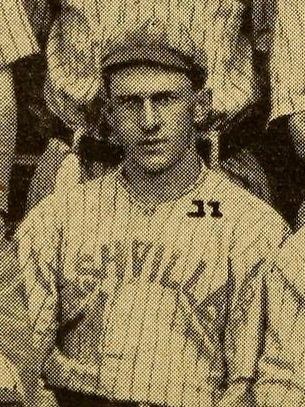0 0 0 0 0 0 Date 11 July 1916 Venue Sulphur Dell | 0 0 0 0 0 0 Location Sulphur Dell, Nashville | |
 | ||
On July 11, 1916, Tom Rogers, who was a member of minor league baseball's Nashville Vols of the Class A Southern Association, pitched a perfect game against the Chattanooga Lookouts. He retired all 27 batters, striking out 4. The game took place at Sulphur Dell in Nashville, Tennessee.
Contents
Rogers' early career
Tom Rogers, who was born in Sparta, Tennessee, began his professional career with the Nashville Vols in the 1914 season. In two seasons with the Vols, Rogers' had a career win–loss record of 17–20 in 46 games, having allowed 149 runs on 305 hits. The St. Louis Browns were close to signing Rogers to a major league contract in 1915, but they felt he was not yet ready and, instead, continued with Nashville in 1916.
1916 season
The 1916 season was Rogers' third year in professional baseball. By July 11, the Vols were in a tight Southern Association pennant race with the New Orleans Pelicans. With one game lead on New Orleans and a pitching staff hampered by injuries, Rogers started the game on only two days' rest.
Game summary
The game took place at Sulphur Dell in Nashville, Tennessee. The Lookouts nearly recorded a hit in the second inning when Joe Harris lead off with a sharply hit line drive to right-center field. Center fielder Billy Lee made a diving catch at the base of the notorious Sulphur Dell right field incline, saving the perfect game bid in its early stages. Through six innings, the game remained scoreless and neither team had achieved a hit. Upset with Rogers' performance, Chattanooga's coaching staff and players began jeering and making disparaging comments toward Rogers.
Leading off the seventh inning for Nashville was Thomas Sheehan. After Sheehan made a hit to deep short, he advanced to second base on Howard Baker's sacrifice hit. Gus Williams then hit a long fly ball to centerfield. The ball was nearly caught by center fielder Bobby Messenger, but he missed the catch when left fielder Joe Harris jumped in front of him, and the ball fell to the ground for an error. This put runners on second and third with only one out. Dick Kauffman then bunted, allowing Sheehan to score for third when pitcher James Allen bobbled the ball. Williams came home to score when Art Kores executed a squeeze bunt. Roy Ellam then walked and Gabby Street popped out to end the inning with the Vols leading two to nothing.
A second great defensive play was made by Vols left fielder Gus Williams in the bottom of the seventh when he crashed into the left field bleacher fence in the act of catching Jake Pitler's sharp hit to left. With two outs in the top of the ninth inning, John Peters came in to pinch hit for Allen. He hit a soft fly ball to second base which was fielded by Sheehan for the final out.
In all, Rogers struck out 4 of the 27 batters he faced. The game lasted just 1 hour and 25 minutes.
Game statistics
Reactions
Thomas "Shotgun" Rogers climbed yesterday to the proudest pinnacle in the baseball world. The Gallatin Gunner, in the most gallant exhibition of slab work ever unfurled in this section of the more or less United States, reported with that fondly cherished dream of every gent who makes the diamond his habitat—a perfect game. One unmarred by either a run, a hit or a hostile son of swat reaching the initial corner.
In a word, the climax of twirling cunning. Like the steady sweep of a giant blade, the Gallatin Gunner's superb pitching mowed down the twenty-seven hostile Lookouts as rapidly as they came to bat. In rare rotation, without exception, the Elberfeld clan were moved into the morgue in every frame of the matchless performance.
Nothing that remotely resembled a hit could the laboring Lookouts prize from the cunning of the Gunner's whip. Not a bobble did his mates contribute behind him. Not a free pass did he give out. Not a batter did he hit and for nine brilliant and bizarre rounds three Lookouts were retired in the order of their appearance at the plate.
Rogers' post-game career
Rogers finished the season with a 24–12 record and having allowed only 75 runs on 243 hits. His 24 wins put him in a three-way-tie for the most wins in the Southern Association in 1916. He went on to play with the American League's St. Louis Browns from 1917 to 1919, the Philadelphia Athletics in 1919, and the New York Yankees in 1921. Rogers continued to play for various minor league teams from 1920 to 1930. His career minor league record was 168–129, while his major league record was 15–30 with a 3.95 earned run average.
